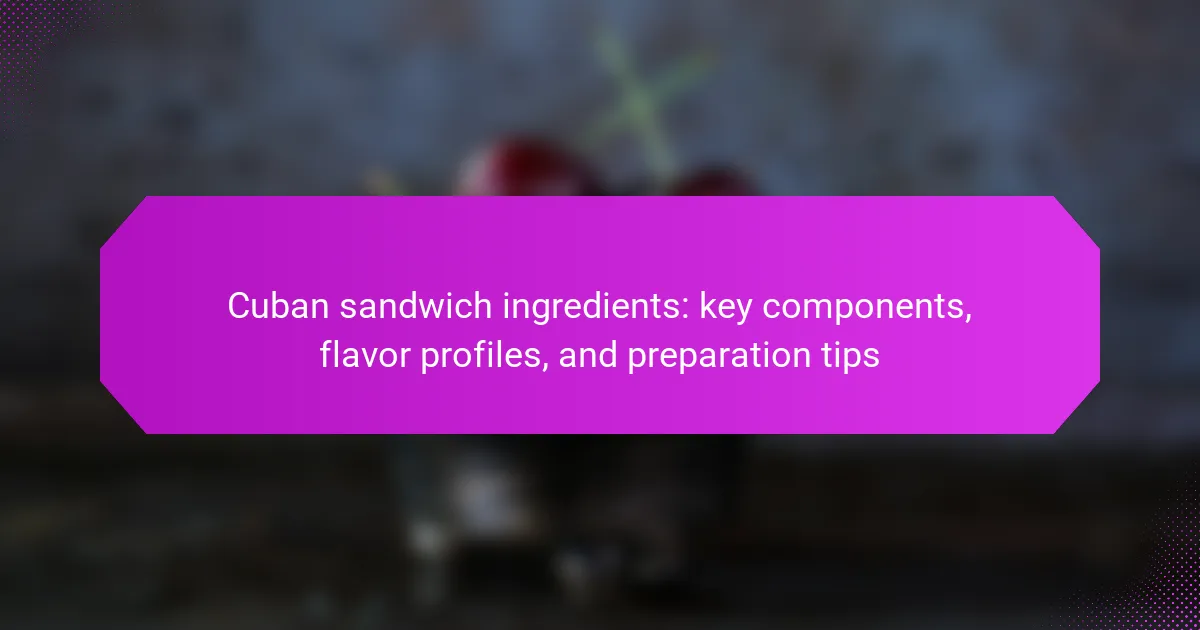The Cuban sandwich is a popular culinary creation characterized by its key ingredients: Cuban bread, roasted pork, ham, Swiss cheese, pickles, and mustard. Each component contributes to a distinctive flavor profile, with roasted pork providing a savory base, ham adding saltiness, Swiss cheese offering creaminess, pickles introducing tanginess, and mustard delivering a zesty kick. This article outlines the essential ingredients, explores their flavor interactions, and provides detailed preparation tips to achieve the perfect Cuban sandwich. By focusing on quality ingredients and proper cooking techniques, readers can enhance their sandwich-making experience and enjoy a balanced and satisfying meal.

What are the key ingredients of a Cuban sandwich?
The key ingredients of a Cuban sandwich are Cuban bread, roasted pork, ham, Swiss cheese, pickles, and mustard. Cuban bread is essential for its unique texture and flavor. Roasted pork provides a savory, tender meat base. Ham adds a salty contrast to the pork. Swiss cheese melts beautifully, creating a creamy texture. Pickles offer a tangy crunch, enhancing the overall taste. Mustard adds a zesty kick, tying all the flavors together. These ingredients combine to create a distinctive and beloved sandwich.
How do each of the ingredients contribute to the overall flavor?
The ingredients in a Cuban sandwich each play a distinct role in shaping its overall flavor. The bread, typically Cuban bread, provides a light and crispy texture, enhancing the sandwich’s structure. Roast pork adds a savory and slightly sweet flavor, complemented by its marinade of garlic, citrus, and spices. Ham contributes a saltiness and richness, balancing the sweetness of the pork. Swiss cheese introduces a creamy, mild taste that melds well with the other ingredients. Pickles add a tangy crunch, providing contrast to the richness of the meats. Mustard brings a sharp, zesty note that cuts through the fat. Each ingredient’s unique flavor profile combines to create a harmonious and satisfying culinary experience, showcasing the balance of savory, sweet, tangy, and creamy elements.
What types of bread are traditionally used in a Cuban sandwich?
Cuban sandwiches are traditionally made with Cuban bread. This bread is a type of white bread that is similar to French bread. It has a soft interior and a crispy crust. Cuban bread is typically made with flour, water, yeast, and salt. It is also known for its unique baking process, which involves steam. This steaming creates the desired texture and crust. The bread is essential for holding the sandwich’s ingredients together. It enhances the overall flavor and experience of the Cuban sandwich.
What meats are essential for an authentic Cuban sandwich?
An authentic Cuban sandwich requires three essential meats: roast pork, ham, and salami. Roast pork is marinated and slow-cooked, providing a flavorful base. Ham adds a sweet and savory layer, enhancing the overall taste. Salami introduces a unique spice, contributing to the sandwich’s complexity. These meats are traditionally layered between Cuban bread, complemented by mustard and pickles. The combination of these meats is crucial for achieving the classic Cuban sandwich flavor profile.
What role do condiments play in enhancing the sandwich’s taste?
Condiments play a crucial role in enhancing a sandwich’s taste by adding flavor, moisture, and complexity. They can provide a balance of acidity, sweetness, and spice that complements the sandwich’s ingredients. For instance, mustard adds tanginess, while mayonnaise contributes creaminess. These flavors can elevate the overall sensory experience of eating a sandwich. According to culinary experts, the right condiment can transform a simple sandwich into a gourmet experience. This is particularly true for Cuban sandwiches, where mustard and pickles are essential for achieving authentic flavor profiles.
Why is cheese an important component in a Cuban sandwich?
Cheese is an important component in a Cuban sandwich because it adds creaminess and flavor. The traditional cheese used is Swiss cheese, which melts well. This melting quality enhances the overall texture of the sandwich. The flavor of Swiss cheese complements the other ingredients, such as pork and pickles. Additionally, cheese helps bind the sandwich together, preventing ingredients from slipping out. The inclusion of cheese also balances the acidity from the pickles. Overall, cheese contributes to the rich, savory profile that defines a Cuban sandwich.
What types of cheese are commonly used?
Swiss cheese and mozzarella are commonly used in Cuban sandwiches. Swiss cheese adds a mild, nutty flavor. It melts well and complements the other ingredients. Mozzarella provides a creamy texture and mild taste. Both cheeses enhance the overall flavor profile of the sandwich. The combination of these cheeses is traditional in many Cuban recipes. They help bind the flavors of the meats and pickles.
How does cheese influence the texture and flavor profile?
Cheese significantly influences the texture and flavor profile of dishes. It adds creaminess and richness, enhancing mouthfeel. The melting properties of cheese create a smooth texture that binds ingredients together. Different types of cheese contribute distinct flavors, ranging from sharp to mild. For example, aged cheeses have more pronounced flavors compared to fresh cheeses. The fat content in cheese also plays a crucial role in flavor release during cooking. Additionally, cheese can provide a salty component, balancing other flavors in a dish. In Cuban sandwiches, cheese enhances the overall taste and texture, making it a key ingredient.

What flavor profiles can be expected from a Cuban sandwich?
A Cuban sandwich features a combination of savory, tangy, and slightly sweet flavor profiles. The primary ingredients include roasted pork, ham, Swiss cheese, pickles, and mustard. The roasted pork provides a rich, meaty flavor. Ham adds a salty and savory element. Swiss cheese contributes a creamy and mild taste. Pickles introduce a sharp tanginess that contrasts with the richness of the meats. Mustard enhances the overall flavor with a slight spiciness and acidity. Together, these components create a balanced and satisfying flavor experience.
How do the ingredients work together to create a unique taste?
The ingredients of a Cuban sandwich work together to create a unique taste through a balance of flavors and textures. The combination of roasted pork, ham, Swiss cheese, pickles, and mustard contributes to a savory and tangy profile. Roasted pork provides a rich, juicy flavor that is complemented by the saltiness of the ham. Swiss cheese adds creaminess and a mild nutty taste, enhancing the overall mouthfeel. Pickles introduce acidity, cutting through the richness of the meats. Mustard adds a sharp, tangy kick that ties the flavors together. The bread, typically Cuban bread, offers a crispy crust and soft interior, providing a satisfying contrast. Together, these ingredients create a harmonious blend that defines the Cuban sandwich’s unique taste.
What are the primary flavor notes found in a Cuban sandwich?
The primary flavor notes found in a Cuban sandwich include savory, tangy, and slightly sweet. The savory notes come from the marinated pork, typically slow-roasted and seasoned with garlic and citrus. The tangy flavor is contributed by the mustard and pickles, which add a sharp contrast to the richness of the meat. The slightly sweet note often comes from the ham used, which is usually glazed or smoked. Together, these flavor profiles create a balanced and satisfying taste experience in the Cuban sandwich.
How does the preparation method affect the flavor profile?
The preparation method significantly influences the flavor profile of a Cuban sandwich. Cooking techniques such as grilling or pressing the sandwich enhance the melding of flavors. Grilling caramelizes the bread, creating a crispy texture and rich taste. The heat also intensifies the flavors of meats like pork and ham. Additionally, marinating ingredients before cooking can infuse deeper flavors. For example, marinated pork shoulder develops a savory, tangy profile that is essential to the sandwich. The choice of cheese and how it melts during preparation adds creaminess, further enhancing the overall flavor. Each preparation method uniquely contributes to the final taste experience.
Why is balance important in the flavor profile of a Cuban sandwich?
Balance is important in the flavor profile of a Cuban sandwich because it enhances the overall taste experience. A Cuban sandwich typically combines savory meats, tangy pickles, and creamy mustard. Each ingredient contributes distinct flavors that must complement each other. For example, the richness of the pork is balanced by the acidity of the pickles. This balance prevents any single flavor from overwhelming the others. Additionally, the harmony of flavors creates a more satisfying bite. A well-balanced Cuban sandwich appeals to a wider range of taste preferences. It ensures that the sandwich is both flavorful and enjoyable, making it a beloved dish in Cuban cuisine.
What happens if one ingredient overpowers the others?
When one ingredient overpowers the others in a Cuban sandwich, it disrupts the intended balance of flavors. The dominant ingredient can mask the subtleties of the other components. For instance, if the mustard is too strong, it may overshadow the savory pork or the tangy pickles. This imbalance can lead to a less enjoyable eating experience. Culinary experts emphasize the importance of harmony in flavor profiles. A well-crafted Cuban sandwich relies on the interplay of all ingredients. When one ingredient is too prominent, it detracts from the overall dish. Maintaining balance is crucial for optimal flavor enjoyment.
How can adjustments be made to achieve a balanced flavor?
To achieve a balanced flavor in a Cuban sandwich, adjustments can be made through careful ingredient selection and proportions. Start by balancing salty, sweet, sour, and savory elements. Use the right amount of mustard for tanginess and pickles for acidity. Incorporate layers of ham, roast pork, and Swiss cheese to create depth. Adjust the ratio of bread to fillings to ensure even flavor distribution. Toasting the sandwich also enhances flavors by creating a crispy texture. These adjustments are essential for a well-rounded taste profile.

What are the best preparation tips for making a Cuban sandwich?
To make a Cuban sandwich, start with quality ingredients. Use Cuban bread for the best texture and flavor. Layer slices of roasted pork, ham, Swiss cheese, and dill pickles. Spread yellow mustard on the bread for added tanginess. Press the sandwich in a sandwich press or skillet until the bread is crispy and the cheese melts. Ensure even heat distribution for a well-cooked sandwich. Allow the sandwich to rest briefly before slicing to maintain structural integrity. These steps enhance the overall taste and presentation of the Cuban sandwich.
How should the ingredients be layered for optimal taste?
Layer the ingredients of a Cuban sandwich starting with the bread as the base. Use Cuban bread or a similar loaf for the best texture. Next, add a layer of mustard for flavor. Place the pickles on top of the mustard to prevent sogginess. Then, add a layer of Swiss cheese for creaminess. Follow this with layers of roasted pork and ham for protein. Finally, top with another slice of bread before grilling. This layering method ensures balanced flavors and prevents ingredients from becoming soggy. Each layer contributes to the overall taste, creating a harmonious blend of flavors.
What techniques can enhance the grilling process?
Marinating ingredients enhances the grilling process. Marinades infuse flavor and moisture into meats. They typically contain acids, oils, and seasonings. Acidic components like vinegar or citrus juice tenderize proteins. Oil helps to prevent sticking and adds richness. Seasonings contribute to the overall flavor profile.
Using a two-zone fire improves heat management. This technique allows for searing and indirect cooking. Searing creates a flavorful crust. Indirect cooking ensures even cooking throughout.
Utilizing a grill thermometer ensures precise temperature control. Accurate temperatures prevent undercooking or burning. This tool helps maintain the ideal grilling environment.
Resting grilled items before serving allows juices to redistribute. This technique enhances flavor and tenderness. Resting for at least five minutes is recommended.
These techniques collectively enhance the grilling process, leading to better flavor and texture in grilled dishes.
How can one avoid common mistakes when making a Cuban sandwich?
To avoid common mistakes when making a Cuban sandwich, focus on using the right ingredients. Use Cuban bread, which is essential for authenticity. Ensure the bread is fresh and soft for optimal texture. Layer the sandwich correctly, starting with mustard, followed by pickles, ham, roast pork, and Swiss cheese. Do not skimp on the ingredients; generous portions enhance flavor. Press the sandwich on a plancha or skillet to achieve a crispy exterior and warm interior. Avoid overcooking, as this can dry out the meat. Lastly, serve the sandwich immediately for the best taste and texture.
What variations of the Cuban sandwich exist?
Variations of the Cuban sandwich include the traditional Cuban, the Miami Cuban, and the vegetarian Cuban. The traditional Cuban sandwich features roasted pork, ham, Swiss cheese, pickles, and mustard on Cuban bread. The Miami Cuban often adds salami, reflecting the influence of Italian immigrants in South Florida. The vegetarian Cuban substitutes meat with grilled vegetables or tofu. Each variation maintains the core elements of bread and cheese but adapts the protein component. These adaptations highlight regional preferences and dietary choices.
How do regional differences influence the preparation of a Cuban sandwich?
Regional differences significantly influence the preparation of a Cuban sandwich. In Miami, the Cuban sandwich often features a combination of ham, roasted pork, Swiss cheese, pickles, and mustard, all pressed between Cuban bread. In contrast, Tampa’s version frequently includes salami, reflecting the city’s Italian heritage. The type of bread used can also vary; while Cuban bread is standard, some regions may substitute with other local breads. Furthermore, the seasoning and cooking methods may differ, with some areas opting for a more garlicky marinade for the pork. These variations highlight the cultural influences and local tastes that shape the Cuban sandwich across different regions.
What are some popular modern twists on the classic Cuban sandwich?
Popular modern twists on the classic Cuban sandwich include the addition of avocado, jalapeños, and different types of bread. Some variations use pulled pork or smoked meats instead of traditional roasted pork. Others incorporate unique cheeses like pepper jack or gouda for added flavor. Additionally, gourmet versions may feature artisan pickles or aioli spreads. These adaptations maintain the essence of the Cuban sandwich while introducing new taste profiles. Various restaurants have embraced these twists to cater to evolving culinary preferences.
What are practical tips for serving and enjoying a Cuban sandwich?
Serve a Cuban sandwich warm and pressed for the best flavor. Use a panini press or a skillet to achieve a crispy exterior. Slice the sandwich diagonally for easier handling and presentation. Pair it with pickles or mustard for added tanginess. Serve alongside plantain chips or a light salad for balance. Enjoy with a refreshing beverage like a mojito or Cuban coffee. Ensure the ingredients are fresh for optimal taste. The classic combination includes roasted pork, ham, Swiss cheese, and mustard on Cuban bread.
The main entity of this article is the Cuban sandwich, a popular culinary dish known for its distinct combination of ingredients. Key components include Cuban bread, roasted pork, ham, Swiss cheese, pickles, and mustard, each contributing to the sandwich’s unique flavor profile of savory, tangy, and slightly sweet notes. The article explores how each ingredient enhances the overall taste and texture, discusses traditional and modern variations, and provides practical preparation tips for crafting an authentic Cuban sandwich. Additionally, it highlights the importance of balance in flavor and offers insights into common mistakes to avoid during preparation.
